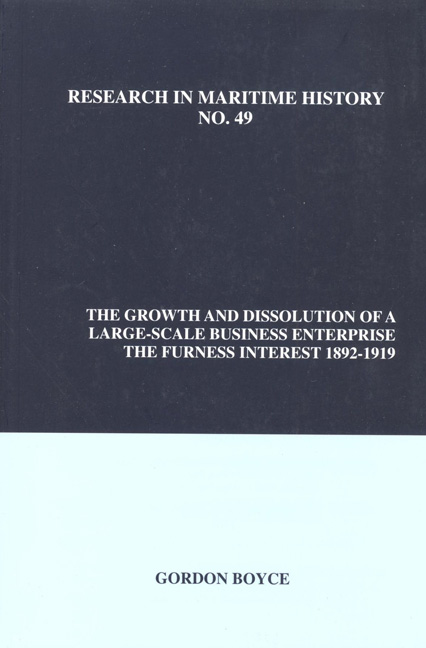Book contents
- Frontmatter
- Table of Contents
- About the Author
- Acknowledgements
- Figures and Tables
- Introduction
- Chapter 1 Furness' Shipping Services: Growth by Organic Means in the 1880s
- Chapter 2 The 1890s: Furness Withy's Expansion by Acquisition and Promotion
- Chapter 3 Diversification into the Industrial Sector, 1895-1901
- Chapter 4 Trouble on the Transatlantic Route: The Formation of the IMM and Furness' Response
- Chapter 5 The Growth of Shipping Services, 1902-1909
- Chapter 6 Industrial Operations and Performance, 1900-1914
- Chapter 7 The Growth of the Shipping Interests, 1910-1919
- Chapter 8 Structure
- Chapter 9 Finance
- Chapter 10 Holding Company Investment Activities and Intermediary Operations
- Chapter 11 Personnel
- Chapter 12 Furness
- Chapter 13 Dissolution
- Appendix 1 Development of the Combined Fleet, 1900-1919
- Appendix 2a Patterns of Ownership: The Furness Group, 1919
- Appendix 2b Reorganization of Branch Offices and Superintending Departments, 1911-1912
- Appendix 3a Fluctuations in Freights, Profits, Tonnage Afloat and Merchant Shipping Output
- Appendix 3b Output of Merchant Tonnage (Excluding Warships), 1892-1913
- Appendix 3c Fluctuations in the Price of a 7500-ton Cargo Steamer, 1898-1913
- Appendix 4 Development of the Furness Group: Principal Promotions, Acquisitions and Divestments, 1880-1919
- Appendix 5 Northern Allies and Maritime Associates
- Appendix 6 Contemporary Accounting Law and Conventions, 1845-1914
- Appendix 7 Lord Furness' Movements, 1899-1912
- Bibliography
Chapter 10 - Holding Company Investment Activities and Intermediary Operations
- Frontmatter
- Table of Contents
- About the Author
- Acknowledgements
- Figures and Tables
- Introduction
- Chapter 1 Furness' Shipping Services: Growth by Organic Means in the 1880s
- Chapter 2 The 1890s: Furness Withy's Expansion by Acquisition and Promotion
- Chapter 3 Diversification into the Industrial Sector, 1895-1901
- Chapter 4 Trouble on the Transatlantic Route: The Formation of the IMM and Furness' Response
- Chapter 5 The Growth of Shipping Services, 1902-1909
- Chapter 6 Industrial Operations and Performance, 1900-1914
- Chapter 7 The Growth of the Shipping Interests, 1910-1919
- Chapter 8 Structure
- Chapter 9 Finance
- Chapter 10 Holding Company Investment Activities and Intermediary Operations
- Chapter 11 Personnel
- Chapter 12 Furness
- Chapter 13 Dissolution
- Appendix 1 Development of the Combined Fleet, 1900-1919
- Appendix 2a Patterns of Ownership: The Furness Group, 1919
- Appendix 2b Reorganization of Branch Offices and Superintending Departments, 1911-1912
- Appendix 3a Fluctuations in Freights, Profits, Tonnage Afloat and Merchant Shipping Output
- Appendix 3b Output of Merchant Tonnage (Excluding Warships), 1892-1913
- Appendix 3c Fluctuations in the Price of a 7500-ton Cargo Steamer, 1898-1913
- Appendix 4 Development of the Furness Group: Principal Promotions, Acquisitions and Divestments, 1880-1919
- Appendix 5 Northern Allies and Maritime Associates
- Appendix 6 Contemporary Accounting Law and Conventions, 1845-1914
- Appendix 7 Lord Furness' Movements, 1899-1912
- Bibliography
Summary
During the period under review, Furness Withy, the British Maritime Trust (BMT) and Houlder Brothers all emerged as large holding companies that provided intermediary functions. For each individual firm, this development occurred at different times, but the trend intensified as Furness shifted responsibility for undertaking investment activities from himself to Group entities. From its inception, Furness Withy resembled a holding company, but the scale of its operating and investing activities grew enormously after 1900. The BMT began its existence as a “pure” financial intermediary, but it drifted into shipowning in the late 1890s and, with the sale of its fleet in 1907, reverted to its original function. When it was acquired in 1910, Houlders had already grown from a managing agency into a small holding company, but as the prewar boom intensified, its portfolio of subsidiaries expanded as did its branch network. Each of the three firms combined investment activities with directly managed business operations, although the BMT did so only temporarily.
In the wider national context, William Kennedy suggested that the competitiveness of the British economy before 1914 was undermined by the lack of intermediary institutions that could fulfil “an informational role through close linkages by ownership or creditor status” on behalf of investors. His chief concern was that without these institutions, the nation did not support “new technologically” advanced industries that were emerging as high-growth sectors overseas. Instead, the City of London directed funds to overseas portfolio investments, a business in which it had long-standing expertise. Herman Deams and Michael Best and Jane Humphries also pointed to the advantages won by continental banks through “financial integration” based on investment ties reinforced by board-level information links. A number of American investment banks developed the same capabilities and played an entrepreneurial role in promoting new firms and industrial combinations. Quite independ ently, some large US firms were sufficiently profitable to diversify into related product and process-related fields from World War I using the M-form structure. In contrast, Ranald Michie argued that Britain did not need institutions to provide intermediary services, since private investors were willing to invest directly in risky, but potentially high-growth ventures. Other scholars found that several British shipping and merchant enterprises employed the holding company format to provide a subtle form of intermediation.
- Type
- Chapter
- Information
- The Growth and Dissolution of a Large-Scale Business EnterpriseThe Furness Interest, 1892-1919, pp. 285 - 298Publisher: Liverpool University PressPrint publication year: 2012



